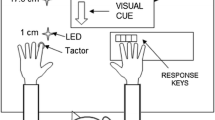Abstract
Parietal neuronal populations have been found which respond bimodally to visual and somatosensory input regarding one’s own limbs or even perceived haptic input of a false limb (Graziano et al., Science 290:1782–1785, 2000). Further, neuronal populations have been observed which respond preferentially to visual stimuli presented in spatial congruence with our hands (Graziano, Proc Natl Acad Sci USA 96:10418–10421, 1999). In this study, we examined event-related potentials (ERPs) elicited by laser dots projected onto or above participants’ index and middle fingers during a sustained-attention task. We hypothesized that visual stimuli projected onto the hand would elicit differences in ERP deflections related to sensory gating and categorization in comparison to when projected close to the hand. Participants responded via a footswitch to rare target flashes of light occurring on or directly above the middle finger of the attended hand. We found enhanced amplitudes of the N1 and P3 deflections when the stimuli fell onto the finger tips as opposed to above them. Furthermore, the N1 for unattended stimuli was less suppressed when the lasers were projected onto the fingers. Behaviorally, participants were less accurate to targets when the lasers fell onto the fingers. We conclude that when the lasers appear to “touch” the participants, they act to automatically draw participants’ attention. Thus visual stimuli projected onto the fingers of the ‘unattended’ hand are harder to filter out, leading to decreases in accuracy during task performance.



Similar content being viewed by others
References
Duhamel J-R, Colby CL, Goldberg ME (1998) Ventral intraparietal area of the macaque: congruent visual and somatic response properties. J Neurophysiol 79:126–136
Farnè A, Pavani F, Meneghello F, Làdavas E (2000) Left tactile extinction following visual stimulation of a rubber hand. Brain 123:2350–2360
Fogassi L, Gallese V, Fadiga L, Luppino G, Matelli M, Rizzolatti G (1996) Coding of peripersonal space in inferior premotor cortex (area f4). J Neurophysiol 76:141–157
Graziano M (1999) Where is my arm? The relative role of vision and proprioception in the neuronal representation of limb position. Proc Natl Acad Sci USA 96:10418–10421
Graziano M, Gross C (1997) Visual responses with and without neurons in premotor cortex encode spatial locations independently of eye position. Exp Brain Res 118:373–380
Graziano M, Yap G, Gross C (1994) Coding of visual space by premotor neurons. Science 226:1054–1057
Graziano M, Cooke DF, Taylor C (2000) Coding the location of the arm by sight. Science 290:1782–1785
Hansen JC, Hillyard SA (1980) Endogenous brain potentials associated with selective auditory attention. Electroencephalogr Clin Neurophysiol 49:277–290
Kennett S, Eimer M, Spence C, Driver J (2001) Tactile-visual links in exogenous spatial attention under different postures: convergent evidence from psychophysics and ERPs. J Cogn Neurosci 13:462–478
Làdavas E, Farnè A, Zeloni G, di Pellegrino G (2000) Seeing or not seeing where your hands are. Exp Brain Res 131:458–467
Maravita A, Iriki A (2004) Tools for the body (schema). Trends Cogn Sci 8:79–86
Näätänen R (1992) Attention and brain function. Erlbaum, Hillsdale, NJ
Näätänen R, Picton T (1987) The N1 wave of the human electric and magnetic response to sound: a review and an analysis of the component structure. Psychophysiology 24:375–425
Picton TW (1992) The P3 wave of the human event-related potential. J Clin Neurophysiol 9:456–479
Press C, Taylor-Clarke M, Kennett PH (2004) Visual enhancement of touch in spatial body representation. Exp Brain Res 154:238–245
Spence C, Nicholls MER, Gillespie N, Driver J (1998) Cross-modal links in exogenous covert spatial orienting between touch, audition, and vision. Percept Psychophys 60:544–557
Stephan KE, Fink GR, Marshall JC (2007) Mechanisms of hemispheric specialization: insights from analyses of connectivity. Neuropsychologia 45:209–228
Taylor-Clarke M, Kennett S, Haggard P (2002) Vision modulates somatosensory cortical processing. Curr Biol 12:233–236
Acknowledgements
The authors thank Margaret Baune, Malarie Deslauries, Tyler Kurtz, Gabrielle Schreier, and Cassandra Wahl for technical assistance, preparing and testing participants, and recording EEG. This project was funded by the National Center for Research Resources (NCRR), National Institutes of Health (NIH), P20 RR020151.
Author information
Authors and Affiliations
Corresponding author
Additional information
This article is published as part of the Special Issue on Multisensory Integration.
Rights and permissions
About this article
Cite this article
Simon-Dack, S.L., Cummings, S.E., Reetz, D.J. et al. “Touched” by Light: Event-Related Potentials (ERPs) to Visuo-Haptic Stimuli in Peri-Personal Space. Brain Topogr 21, 261–268 (2009). https://doi.org/10.1007/s10548-009-0096-3
Received:
Accepted:
Published:
Issue Date:
DOI: https://doi.org/10.1007/s10548-009-0096-3




